Minimize Operational Time
BMG LABTECH provides both single and multi-mode microplate readers which researchers use extensively in microbiology. Plate readers can help expand experimental possibilities when studying synthetic biology, microbiomes or biofilms.
Classically, in bacterial experiments, a growth curve was created by drawing aliquots and measuring absorbance at 600 nm in a cuvette. Instruments from BMG LABTECH offer streamlined solutions which allow for a modern approach to real-time monitoring of the growth of multiple samples (6-384 wells) with no manual intervention.
Increase Experimental Output
Plate readers from BMG LABTECH offer a true “walk-away” solution that saves time and reduces user intervention. Instruments provide rapid, automated kinetic detection that can span from seconds to days.
As well as absorbance, the multi-mode readers can detect luminescent and fluorescent signals in the same run. This means that the cell growth rate can be measured in relation to O2 consumption or gene expression can be normalized to cell density. All readers are compatible with robots so higher throughput can be easily automated with all of the leading platforms.
Replicate Specific Growth Conditions
Even for the most fastidious microbes, the best growth conditions can be achieved. This is due to the precise regulation of O2 and CO2 concentrations, accurate temperature control to 65 oC and multiple shaking options with various modes and speeds.
Customer Service, Reliability and Savings
BMG LABTECH provides free application support for the lifespan of the instrument. Furthermore, access to knowledge and expertise from specialists at BMG LABTECH ensures the instrument performs optimally and the best data is generated for experiments.
“Made-in-Germany” dependability is by design with BMG LABTECH, encompassing the philosophy that all instruments need to be of the highest standard of functionality and reliability. Therefore, readers from BMG LABTECH achieve not only the highest brand satisfaction on the market, but also have the lowest cost of ownership.
After extensive testing of five different brands of microplate readers, only BMG LABTECH instruments were found to have the sensitivity, durability and reliability required for our applications.
Associate Professor Christopher McDevitt, Group Leader The Peter Doherty Institute for Infection and Immunity, The University of Melbourne, Australia
Key Features to Keep both Microbes and Researchers Happy
Temperature Regulation
Microorganisms require different temperatures for optimizing growth rates. Readers from BMG LABTECH include accurate temperature regulation up to 65 oC in order to ensure optimal growth conditions. Uniform temperature is guaranteed by the specific incubation zone, which also minimizes evaporation. It is simple to compare events at different temperatures as the temperature values are logged to the signal curve.
Shaking
To ensure growth or to disperse cultures into an even suspension, most microbes require aeration. Speeds are adjustable up to 700 rpm or optionally to 1100 rpm and there are three shaking modes, providing optimum settings for a specific strain. When shaking 24/7 is required, readers can also be equipped with a very robust transport system.

Linear, orbital and double-orbital shaking mode. Image credits: BMG Labtech.
Atmospheric Control Unit
Microorganisms have a diverse living environment and precise atmospheric control is needed in order to replicate this in a plate reader. In order to establish an environment conductive for growth, the Atmospheric Control Unit (ACU) independently regulates CO2 and O2 inside the reader. This means that long-term measurements can be made at stable CO2 (0.1 – 20%) and O2 (0.1 – 20%) atmospheres which are perfect even for the most fastidious organisms. To study responses to changing gas conditions in real-time, gas ramping can be used.
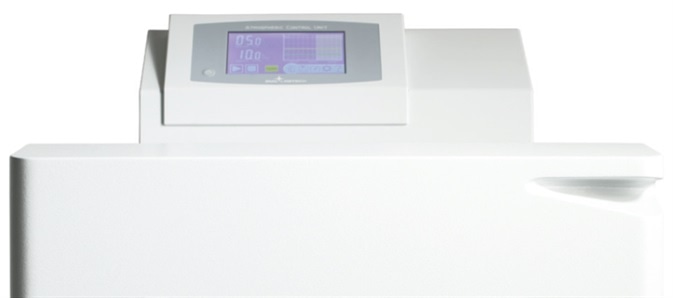
ACU perfectly regulates both O2 and CO2. Image credits: BMG Labtech.
Well Scans
Mostly, microbial assays are non-homogenous. Therefore, experiments might benefit from a signal captured over the entire well-surface in either an orbital or spiral pattern. This ensures the most accurate measurement. Multiple read points over the well surface can be acquired by more detailed matrix scan options (from 2x2 to 30x30) and this displays the signal variation in a matrix.
When studying non-homogenous samples, like flocculating yeast or bacteria, this is very advantageous. It is also beneficial for biofilm forming bacteria to examine biofilm shape and size in more detail.
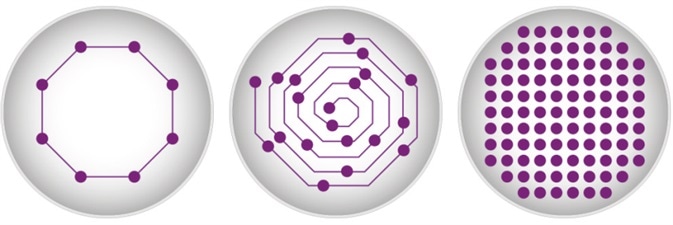
Orbital, spiral averaging, and matrix scan. Image credits: BMG Labtech.
Multiplexing
To analyze multiple parameters, OD600 can be combined with fluorescent or luminescent detection of up to five different dyes in a single run. This enables multiplex assays to be designed and performed. For example, the growth characteristics and effects from a variety of bioactives can be followed in the same well, or the growth of multiple strains that have different fluorescently tagged genes can be monitored in a single well.
The patented LVF-MonochromatorTM provides even more flexibility and allows the user to select any bandwidth and wavelength for luminescent or fluorescent measurement. This makes it the most versatile reader available.
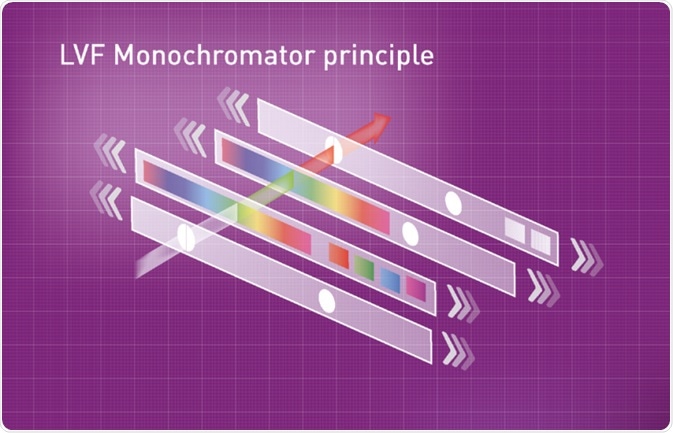
Simplifi ed schematic of the LVF Monochromator technology. Image credits: BMG Labtech.
Growth of Neisseria Meningitidis in a BMG LABTECH Microplate Reader with Atmospheric Control Unit (ACU)
Kerry L. Cutter University of the West of England, Bristol
Summary
It is well understood that a specific level of carbon dioxide (CO2) is needed for microorganisms to grow and reproduce. When this level is increased, it usually corresponds to the lag phase, during which the organism is unable to divide until the critical concentration of CO2 is reached. Neisseria meningitidis is a suitable organism to study the effects of CO2 because it is thought to require or benefit from a CO2 concentration greater than the atmospheric concentration.
The efficiency of delivering 5% CO2 with a BMG LABTECH multi-mode plate reader coupled with an Atmospheric Control Unit (ACU) was assessed using a strain of Neisseria meningitidis. By detecting absorbance at 405 nm and comparing data to that obtained on a microplate reader without ACU, growth was determined. The BMG LABTECH plate reader with ACU can achieve and maintain a level of CO2 required for culturing such a fastidious organism.
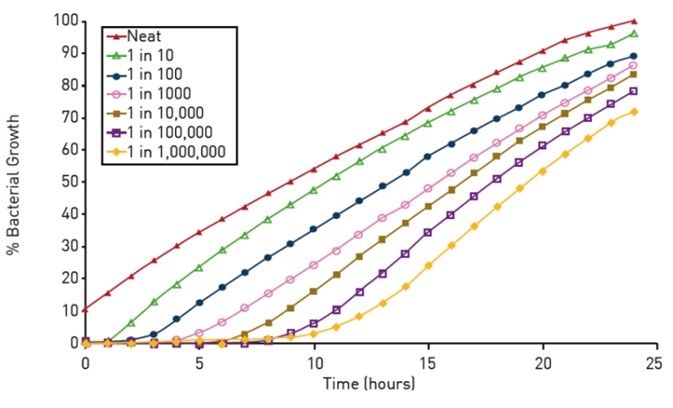
Growth of serially diluted cultures of Neisseria meningitidis in BHI broth
supplemented with 10% FBS using a BMG LABTECH plate reader with ACU
set to deliver 5% CO2 at 37 °C. The data presented were calculated from
triplicate optical density readings (at 405 nm) taken hourly over a 24 h period
from duplicate experiments. Image credits: Kerry L. Cutter.
Monitoring Bacterial Cell-to-Cell Communication “Quorum Sensing” Using a BMG LABTECH Microplate Reader
K.E. Eboigbodin and G.K. Robinson Dept. of Biosciences, University of Kent, Canterbury, CT2 7NJ
Summary
Bacteria communicate using a process called quorum sensing, whereby they produce, detect and respond to low molecular mass molecules called autoinducers (AI). This is a process that is well-described in Vibrio fischeri. With high cell density, this organism turns bioluminescent. The molecule responsible for the development of bioluminescence is N-3-oxo-hexanoyl-L-homoserine lactone (3-oxo-C6-HSL).
Bioluminescence of V. fischeri was detected using a BMG LABTECH microplate reader. This was used to report on quorum sensing and to relate it to the density of the cell, determined by OD600 measurements. In order to study cell-to-cell communication, V. fischeri strains mutated in genes required for luminescence were exposed to 3-oxo-C6-HSL. The combination of absorbance and luminescence measurements meant that microbial growth could be monitored at the same time as bioluminescence. Therefore, a specific signal and an internal control can be acquired which allows a ratiometric read-out.
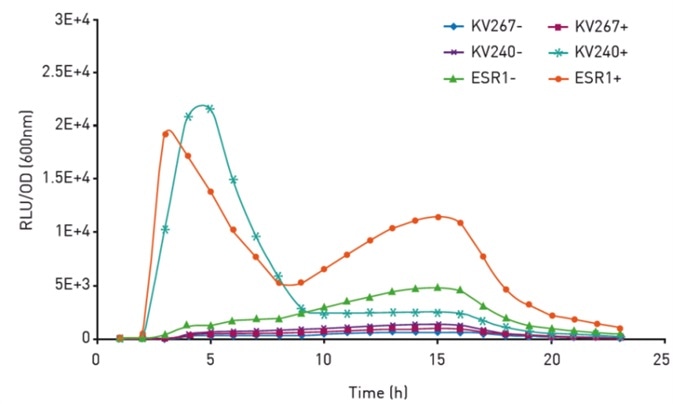
Normalized bioluminescence of V. fi scheri strains. Bacteria were either supplemented with exogenous HSL (+) or not (-). Insert shows growth curves. Image credits: K.E. Eboigbodin and G.K. Robinson.
Growth of Campylobacter Using a Microplate Reader Equipped with ACU
R.D. Haigh and J.M. Ketley Department of Genetics, University of Leicester
Summary
The Campylobacter jejuni bacterium causes food poisoning, with symptoms including diarrhoea, fever, and abdominal pain. To mimic the conditions found in the intestines of its hosts, C. jejuni is cultured at 5 – 8% O2, 10% CO2 and 37 – 42 oC.
In this example, C. jejuni growth studies performed in 8 ml scale were compared with growth curves from a 96 well microplate. Atmospheric control was achieved using either a VAIN workstation or the Atmospheric Control Unit of a microplate reader, respectively. In order to assess biomass, optical density at 600 nm was acquired in either a cuvette or directly in the microplate. The comparison of Campylobacter growth in tubes and in 96 well plates shows that, although fastidious, this organism can be transferred to a 96 well format. The BMG LABTECH microplate reader makes this easy by providing shaking and atmospheric control as well as controlling the temperature.
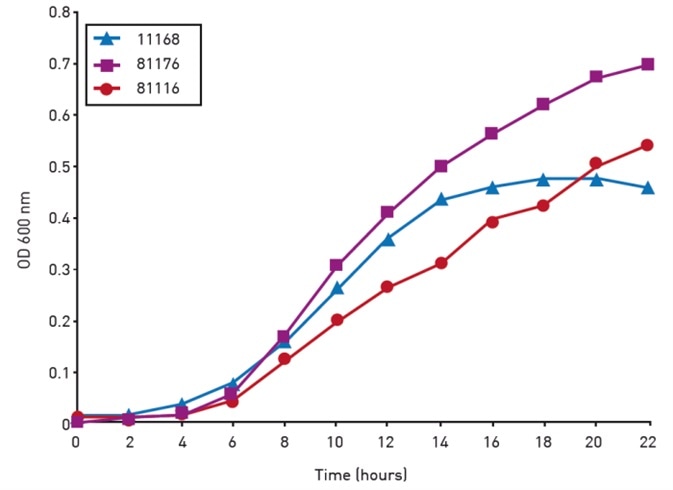
Growth of Campylobacter isolates over a 24 hour period in the FLUOstar® Omega. Image credits: R.D. Haigh and J.M. Ketley.
Expression of a Stable GFP Mutant in Group B Streptococcus. Growth, Detection and Monitoring
Matthew J. Sullivan and Glen C. Ulett, School of Medical Science, and Menzies Health Institute Queensland, Griffith University, Gold Coast, Queensland, Australia
Summary
Group B streptococcus (GBS), or Streptococcus agalactiae, is associated with a variety of diseases including arthritis, neonatal disease, pneumonia, sepsis, skin and soft tissue infections and meningitis. For the most part, host colonization and virulence are studied using fluorescent biomarkers and microscopy. So far, strategies for labeling GBS with fluorescent biomarkers have been linked to antibody-based immunostaining methods and non-specific protein/DNA strains.
A common labeling method for bacteria is green fluorescent protein (GFP) and it enables the monitoring of the subcellular locations of bacteria in eukaryotic host cells or identification of bacteria in complex samples. Stable expression of a green fluorescent protein mutant (GFPmut3) has recently been reported, with enhanced fluorescence intensity in GBS.
The CLARIOstar multi-mode plate reader was used to measure validation and stability of GFPmut3 expression in GBS cultures. This process utilized the fluorescence polarization, fluorescence intensity and absorbance measurement capabilities of the plate reader.
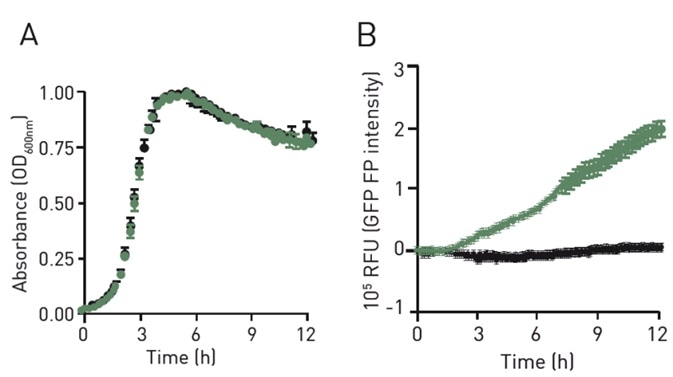
Absorbance (A) and polarized fl uorescence intensity profi le (B) of GFP+
GBS (green) and GFP- GBS (black) grown in CDM media. Image credit: Matthew J. Sullivan and Glen C. Ulett.
About BMG Labtech

BMG LABTECH has been committed to producing microplate readers for more than twenty years. By focusing on the needs of the scientific community, the company’s innovative microplate readers have earned the company the reputation of being a technology leader in the field.
BMG LABTECH has developed a wide range of dedicated and multi-mode microplate readers for life sciences applications and high-throughput screening.
All BMG LABTECH microplate readers are "Made in Germany" and are conceived, developed, assembled, and tested entirely at our headquarters in Germany.
Since our establishment in Offenburg, Germany in 1989, BMG LABTECH has expanded to offer a worldwide sales and support network with offices in the USA, UK, Australia, Japan and France. Our subsidiaries, regional offices and distributors are committed to bringing you innovative microplate reader technology with the quality and reliability you expect from a German company.
Our staff includes engineers and scientists from the fields of biology, biochemistry, analytical chemistry, and physics.
Sponsored Content Policy: News-Medical.net publishes articles and related content that may be derived from sources where we have existing commercial relationships, provided such content adds value to the core editorial ethos of News-Medical.Net which is to educate and inform site visitors interested in medical research, science, medical devices and treatments.